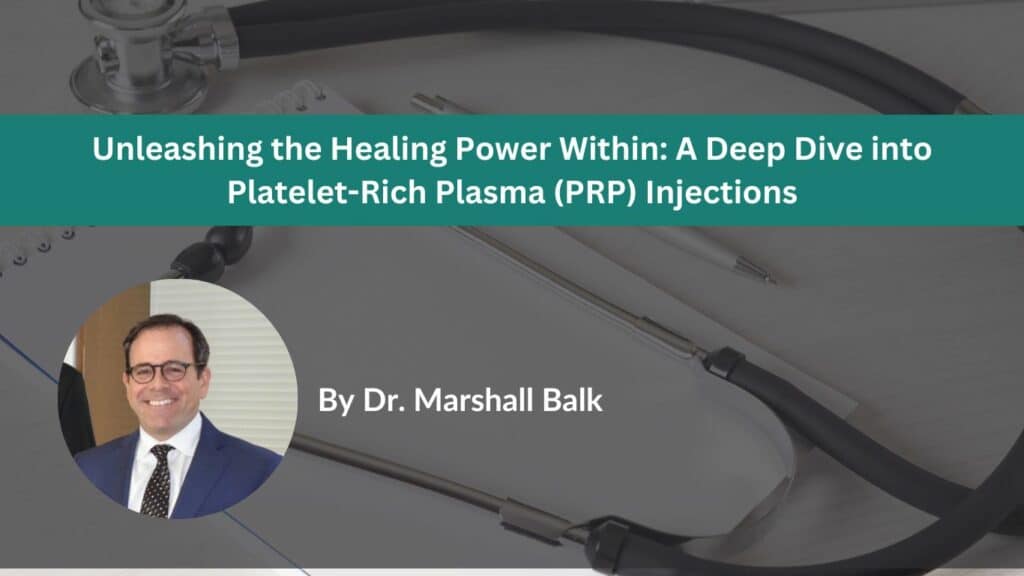The regenerative medicine field has seen tremendous advancements over the past few decades. One of its most promising therapies is Platelet-Rich Plasma (PRP) Injections, a treatment that leverages the body’s natural healing capabilities to accelerate the repair of injured tissues. From treating common sports injuries to delaying the signs of aging, PRP injections are revolutionizing the medical industry.
Understanding Platelet-Rich Plasma (PRP)
Platelet-Rich Plasma (PRP) is a component of your blood, enriched with platelets. Platelets, also known as thrombocytes, are cells responsible for blood clotting and essential growth healing functions. But their role doesn’t stop there. They are also packed with growth factors, proteins that play a crucial role in the healing process.
PRP therapy uses these growth factors to enhance the body’s natural healing capabilities. By injecting a concentration of a patient’s own platelets into injured areas, PRP injections accelerate the healing of tendons, ligaments, muscles, and joints, improving musculoskeletal problems.
The PRP Preparation Process
PRP injections are prepared from the patient’s blood. The process involves taking one to a few tubes of blood and running it through a centrifuge. This machine separates the platelets from other blood components, concentrating them into a plasma fluid.
In some cases, ultrasound imaging is used to guide the injection process, ensuring the activated platelets are injected directly into the injured or diseased tissue. This action releases growth factors that stimulate and increase the body’s reparative cells.
Who Can Benefit from PRP Injections?
PRP injections are not a one-size-fits-all treatment. They are often recommended for patients suffering from:
- Chronic tendon injuries: These include tennis elbow, golfer’s elbow, Achilles tendonitis, and jumper’s knee.
- Acute sports injuries: Such as pulled hamstring muscles, ligament and muscle injuries, and knee sprains.
- Post-surgical repair: PRP can improve healing after surgery for certain injuries, such as torn tendons.
- Osteoarthritis: Particularly knee osteoarthritis, where PRP can help lessen pain, improve function, and potentially assist in cartilage repair.
The Effectiveness of PRP Injections
While PRP injections show promise, their effectiveness varies depending on the condition being treated. For example, studies have shown significant results when treating tennis elbow and knee osteoarthritis. However, the research results have been inconsistent for conditions like knee and ankle osteoarthritis and Achilles tendinitis.
Furthermore, the effectiveness of PRP treatment can be influenced by factors such as the area of the body being treated, the overall health of the patient, the nature of the injury (acute or chronic), and the composition of the PRP preparation.
Potential Risks and Side Effects
Like any medical procedure, PRP injections carry some risks. These include possible nerve injuries, tissue damage, and pain at the injection site. However, because the injections are created from the patient’s own blood, the risk of rejection or negative reaction is minimal.
The Cost Factor
While PRP injections are a promising treatment, they come with a significant cost. Most insurance plans do not cover PRP treatment, which can range from $1,000 or more per treatment.
PRP Injections and Cosmetic Procedures
In addition to treating orthopedic conditions, PRP injections are also used in cosmetic procedures to treat signs of aging, such as wrinkles. This therapy promotes collagen production, rejuvenates the skin, and enhances overall skin tone and texture.
The Future of PRP Injections
Despite the mixed research results, the potential of PRP injections must be considered. The therapy may hold the key to treating a range of health conditions, from orthopedic injuries to hair loss. As research continues, we can expect to learn more about the full potential of PRP injections.
Conclusion
Platelet-Rich Plasma Injections are a groundbreaking development in the field of regenerative medicine. By harnessing and amplifying the body’s natural healing capabilities, this therapy offers hope for faster, more effective recovery from a variety of conditions. As science continues to evolve, the future of PRP injections looks promising, potentially leading us to a new era of healing and recovery.
While the decision to undergo PRP injections should always be made in consultation with a healthcare professional, it is important to stay informed about the potential benefits and risks associated with this therapy. By doing so, you can make an informed decision about whether PRP injections are the right choice for you.
“Platelet-Rich Plasma (PRP) Injections are revolutionizing the medical industry by harnessing the body’s natural healing powers.”
Table 1: Potential Benefits and Risks of PRP Injections
| Potential Benefits | Potential Risks |
| Accelerated healing of tendons, ligaments, muscles, and joints | Possible nerve injuries |
| Improved musculoskeletal problems | Tissue damage |
| Reduced need for anti-inflammatories or stronger medications | Pain at the injection site |
| Few side effects as injections are created from patient’s own blood | High cost that is often not covered by insurance |
List of Conditions Treated by PRP Injections:
- Chronic tendon injuries
- Acute sports injuries
- Post-surgical repair
- Osteoarthritis
- Signs of aging (in cosmetic procedures)
- Hair loss (in some cases)

